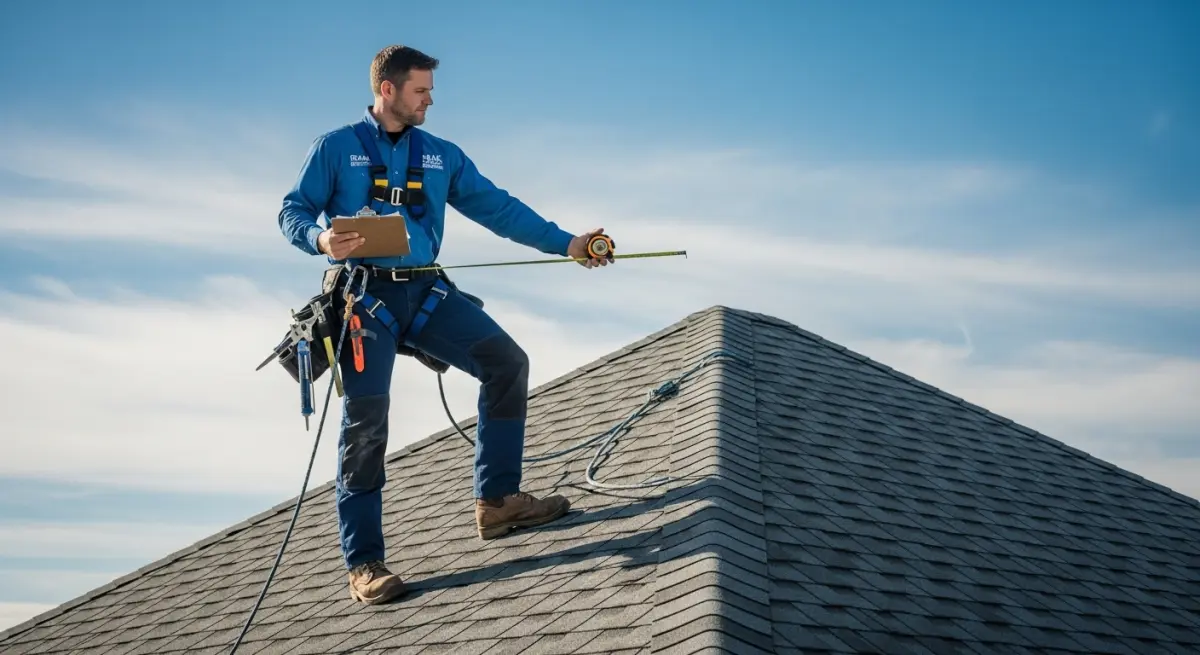Chimney Flashing Repair: Protecting Your Roof from Chimney Leaks
Chimney flashing repair ranks among the most critical yet frequently neglected roofing maintenance tasks. The flashing system around chimneys creates a watertight barrier where brick penetrates your roof—one of the most vulnerable leak points on any home. When chimney flashing fails, water infiltrates walls and ceilings, causing thousands in damage before you notice visible stains. Understanding proper chimney flashing systems, recognizing failure signs, and knowing when to repair versus replace protects your home from expensive water damage.
Understanding Chimney Flashing Systems
Properly installed chimney flashing uses a two-part system that many homeowners don't understand. Step flashing consists of L-shaped metal pieces installed along chimney sides, woven between shingles in overlapping layers. Each piece directs water downward like roof shingles themselves. Counter-flashing, embedded into mortar joints and folded down over step flashing, prevents wind-driven rain from penetrating underneath.
Base flashing at the chimney bottom sits on top of shingles and extends up the chimney face. Wide chimneys require a cricket (also called saddle)—a peaked structure on the uphill side that diverts water around the chimney. Without crickets, water pools behind chimneys and eventually forces through flashing seams. Understanding these components helps identify problems when flashing repairs become necessary.
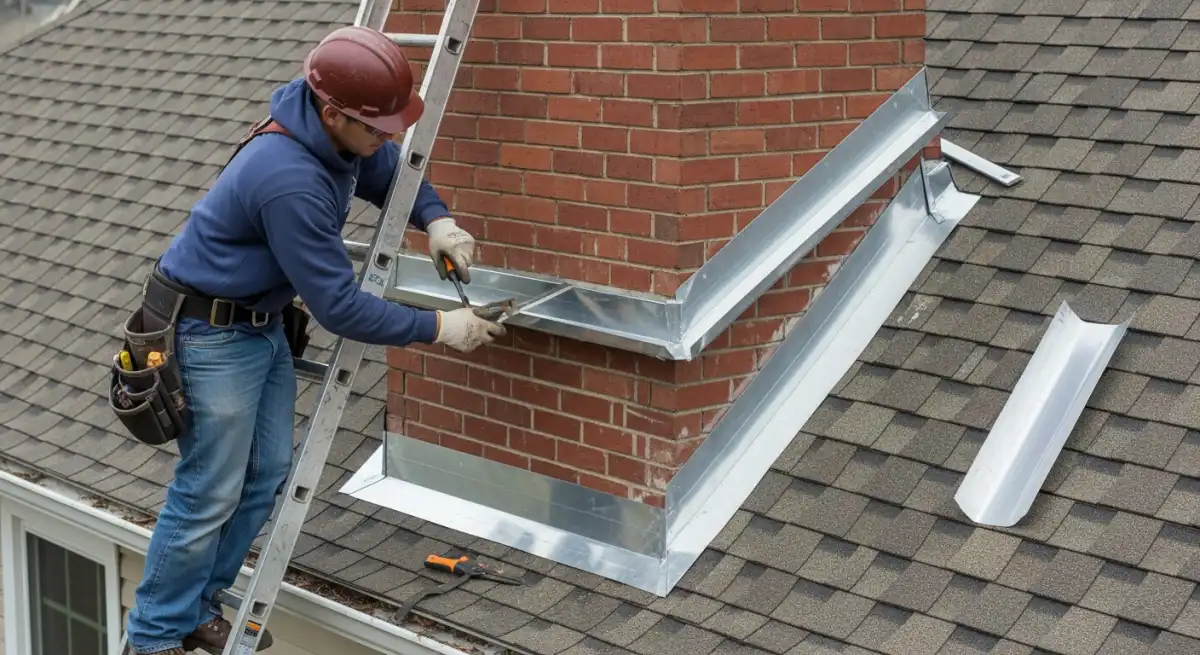
Signs Your Chimney Flashing Needs Repair
Water stains on ceilings or walls near the chimney signal flashing failure. Moisture running down the interior chimney face during rain points directly to compromised flashing. Rust or corrosion on visible flashing metal indicates deterioration that allows water penetration. Gaps between flashing and chimney or between flashing pieces create obvious leak pathways.
Loose or missing counter-flashing leaves step flashing exposed to weather. Deteriorated mortar joints no longer hold counter-flashing securely. Cracked sealant around flashing edges fails to keep water out. Shingles surrounding chimney flashing showing water damage or granule loss reveal ongoing leaks. Don't ignore these warning signs—small flashing leaks rapidly become major water damage requiring expensive repairs beyond just roof leak fixes.
Common Causes of Chimney Flashing Failure
Improper installation tops the list of flashing failure causes. Contractors who skip counter-flashing to save time create immediate weak points. Inadequate overlap between step flashing pieces allows water intrusion. Using wrong materials—thin aluminum instead of heavier gauge metal, or dissimilar metals that create galvanic corrosion—causes premature failure.
Northern Virginia's freeze-thaw cycles stress flashing systems severely. Ice expansion loosens fasteners and opens seams. Settlement in older homes pulls chimneys away from houses, creating gaps. Deteriorated mortar joints lose grip on counter-flashing. Even quality installations eventually fail as sealants dry out, metal corrodes, or physical damage from falling branches punctures flashing. Understanding failure patterns helps prevent recurring problems after repair. Regular inspection catches issues before they escalate like other common roof problems.
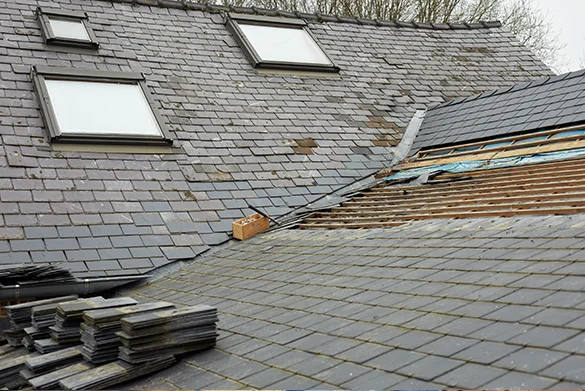
Step Flashing: The First Line of Defense
Step flashing installation requires precision. Each L-shaped piece measures typically 8-10 inches long and wide, installed alongside chimney at each shingle course. One leg extends 4-5 inches up the chimney, while the other lies flat under shingles. Proper overlap means each piece covers the one below by at least 3 inches, creating a shingled effect that channels water downward.
Quality step flashing uses 16-26 gauge galvanized steel, aluminum, or copper depending on roof lifespan and budget. Each piece should be fastened to roof deck—not chimney—allowing independent movement as chimney settles. Common mistakes include inadequate overlap, fastening to chimney (which cracks flashing as chimney moves), or using insufficient quantity of pieces. Proper step flashing installation follows the same attention to detail required for quality metal roofing projects.
Counter-Flashing: Critical Protection Layer
Counter-flashing completes chimney waterproofing by covering step flashing edges. Proper installation requires cutting reglets (slots) into mortar joints with masonry saw, inserting metal counter-flashing 1-1.5 inches deep, then sealing with polyurethane caulk. The flashing folds down over step flashing, creating a lap that prevents wind-driven rain from getting underneath.
Many older chimneys lack proper counter-flashing because installers used only sealant instead—a shortcut that fails within years. True counter-flashing embedded in masonry lasts decades. Repair involves removing old sealant, cutting proper reglets if they don't exist, installing new counter-flashing, and sealing correctly. This specialized work requires masonry skills beyond basic roofing, explaining why DIY chimney flashing repair often fails. Professional expertise ensures results matching quality contractor standards.
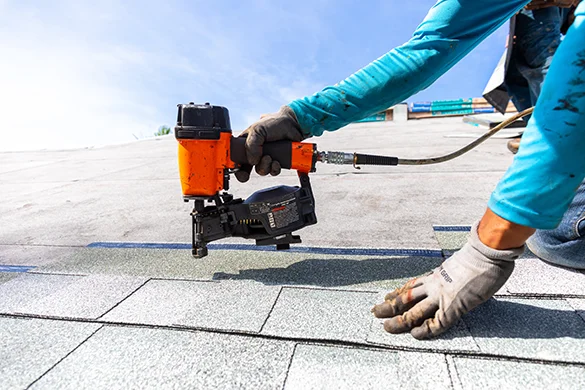
Chimney Cricket: Preventing Water Pooling
Chimneys wider than 30 inches need crickets on the uphill side. These peaked structures divert water flow around chimneys instead of letting it pool behind them. Without crickets, water accumulates during heavy rain and forces its way through flashing seams no matter how well installed. Ice dams compound the problem in winter, creating standing water that freezes and expands.
Cricket construction involves building a peaked frame from pressure-treated lumber, sheathing with plywood or OSB, covering with ice and water shield, then integrating flashing that ties into both roof and chimney systems. Proper crickets add significant complexity and cost to chimney flashing but prevent recurring leaks on wide chimneys. Retrofitting crickets during flashing repair costs $800-1,500 but solves problems that otherwise return every few years. This investment parallels the long-term value of upgrading to systems like TPO roofing for comprehensive protection.
DIY vs. Professional Chimney Flashing Repair
Minor chimney flashing repairs like re-sealing small gaps or replacing damaged sealant suit capable DIYers. These fixes require quality polyurethane or butyl rubber caulk rated for roofing, costing $10-20 per tube. Simple re-sealing addresses temporary water intrusion when underlying flashing remains intact.
However, complete chimney flashing replacement demands professional expertise. Properly cutting reglets in masonry without damaging chimney requires specialized tools and skills. Installing step flashing means removing and reinstalling multiple shingle courses. Fabricating and installing counter-flashing to ensure proper water shedding takes experience. Most importantly, mistakes cause leaks worse than the original problem while voiding any warranties. Professional repair costs $800-2,000 depending on chimney size and complexity but delivers results that last 20+ years. Compare this to recurring DIY failures requiring multiple repair attempts. Working with experts who understand comprehensive roofing systems ensures proper solutions.
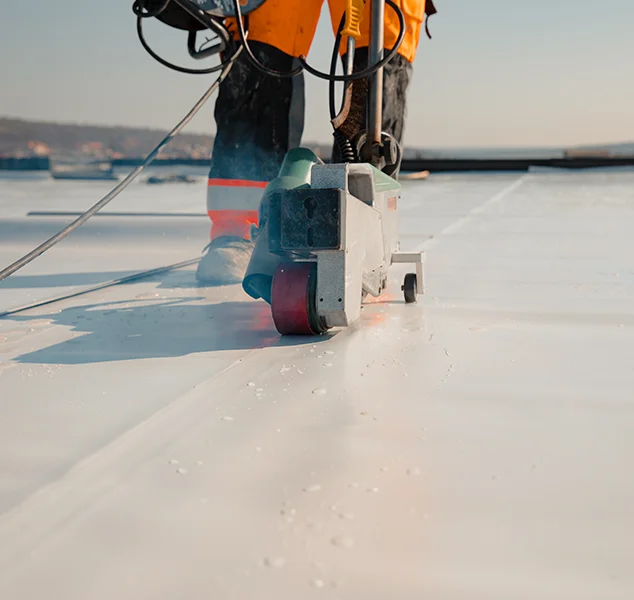
Chimney Flashing Materials: Which to Choose
Galvanized steel remains the most economical choice at $2-4 per linear foot, lasting 20-30 years when properly installed. Pre-painted steel adds color options and extra corrosion resistance. Aluminum costs $3-6 per linear foot, weighs less, and resists corrosion better but dents more easily during installation and from impacts.
Copper represents the premium option at $15-25 per linear foot but lasts 70+ years with minimal maintenance. It develops a protective patina that enhances durability and appearance. Stainless steel ($10-18 per linear foot) provides excellent corrosion resistance without copper's expense. Match flashing material lifespan to your roof—copper makes sense for permanent installations or premium roofs like metal roofing systems but overspends on 20-year asphalt shingles nearing replacement. Budget-conscious choices work fine when properly installed and maintained.
Cost of Chimney Flashing Repair
Simple re-sealing and minor repairs run $200-400 for materials and labor when flashing structure remains sound. Partial flashing replacement on one chimney side costs $400-800 depending on size and accessibility. Complete chimney flashing replacement including step flashing, counter-flashing, and all sealants ranges $800-1,500 for standard chimneys.
Large or complex chimneys requiring cricket installation, extensive masonry work, or premium materials like copper push costs to $2,000-3,500. While these prices seem high, compare them to water damage repair costs. A single ceiling repair from chimney leaks easily runs $2,000-5,000 once you factor in drywall, insulation, paint, and potential mold remediation. Timely flashing repair represents excellent value compared to the alternative. Similar to other major decisions, understanding total cost implications helps budget appropriately.
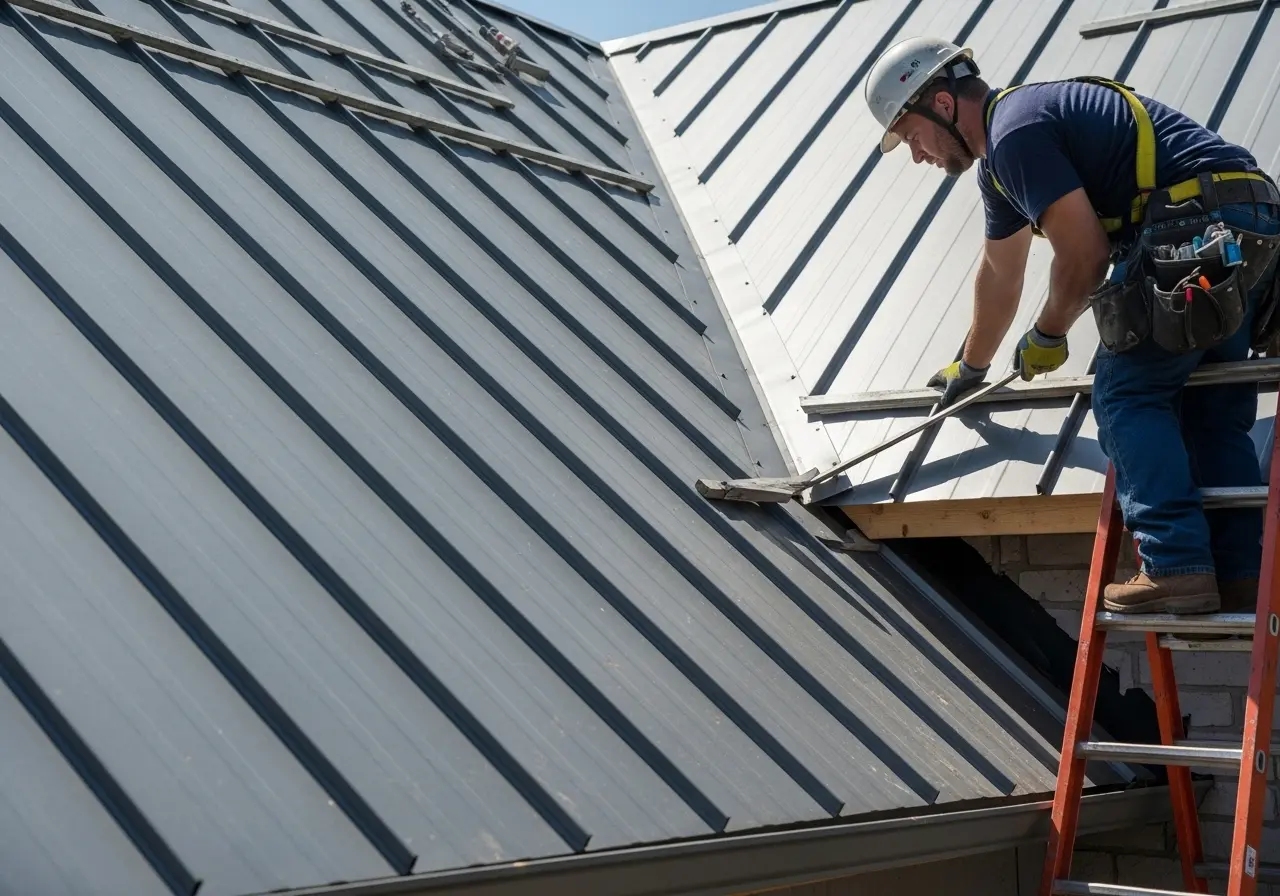
Preventing Future Chimney Flashing Problems
Annual inspections catch chimney flashing issues before they leak. Examine visible flashing for rust, gaps, or loose sections. Check attic spaces near chimneys after heavy rains for water stains. Monitor mortar condition—deteriorating joints can't hold counter-flashing securely. Address small problems immediately before they escalate.
Clear debris from areas around chimneys that can trap moisture against flashing. Trim overhanging branches that drop leaves and can physically damage flashing. Re-seal joints every 5-7 years as preventive maintenance—far cheaper than leak repairs. Consider upgrading to premium materials during repairs if you plan to keep your home long-term. Proper maintenance extends flashing lifespan significantly, similar to benefits gained from comprehensive roof maintenance programs.
When to Replace vs. Repair Chimney Flashing
Minor sealant failures and small gaps suit repair. If underlying metal remains intact without rust-through or physical damage, re-sealing provides years more service at minimal cost. Loose counter-flashing that needs re-securing represents straightforward repair rather than replacement.
Replace flashing when metal shows rust holes, severe corrosion, or extensive physical damage. If more than 25% of flashing requires attention, complete replacement often costs less than extensive piecemeal repairs. Missing counter-flashing that was never properly installed demands full replacement with correct installation. When replacing roof shingles, always replace chimney flashing simultaneously—accessing flashing costs most of total expense, so partial replacement makes no sense. Understanding these thresholds mirrors decision-making for repair versus replacement choices on roofing overall.
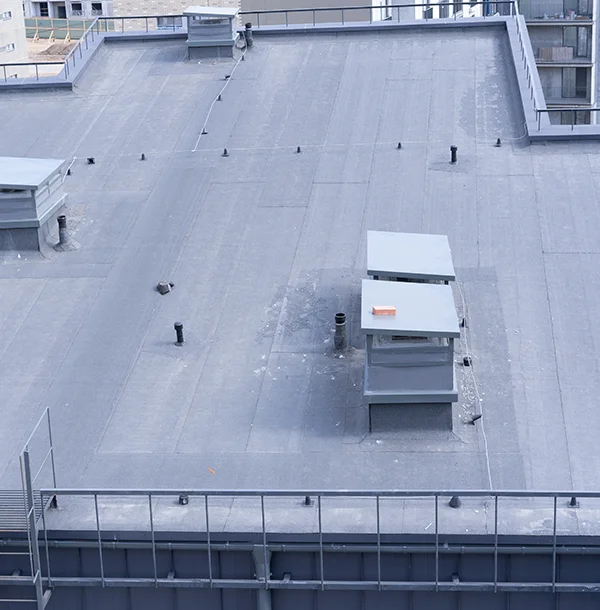
Expert Chimney Flashing Repair Services
Reston Roof specializes in chimney flashing repair and replacement throughout Northern Virginia. Our experienced team understands the complexities of two-part flashing systems, proper counter-flashing installation, and cricket construction for wide chimneys. We provide thorough assessments, transparent pricing, and quality workmanship that stops chimney leaks permanently.
Serving homeowners in Reston, Fairfax, Arlington, and throughout the region, we deliver comprehensive chimney flashing services including inspection, repair, complete replacement, and preventive maintenance programs. Contact Reston Roof at (571) 453-6515 for expert chimney flashing evaluation and honest recommendations that protect your home for decades to come.
